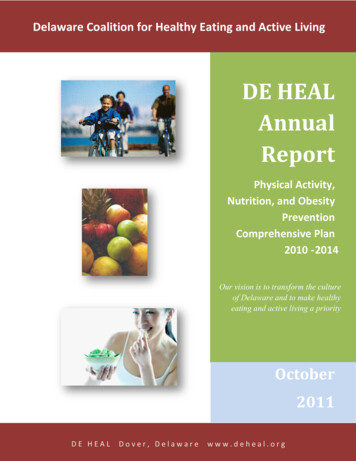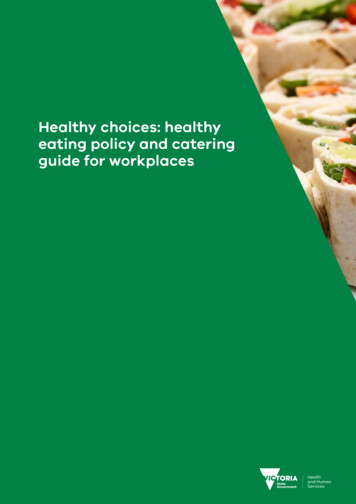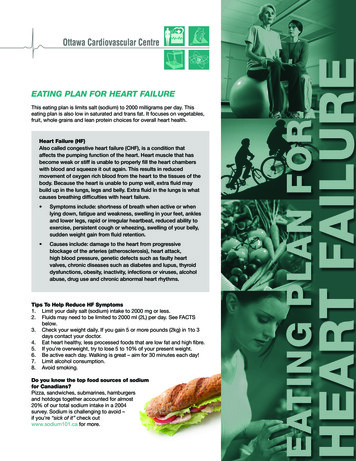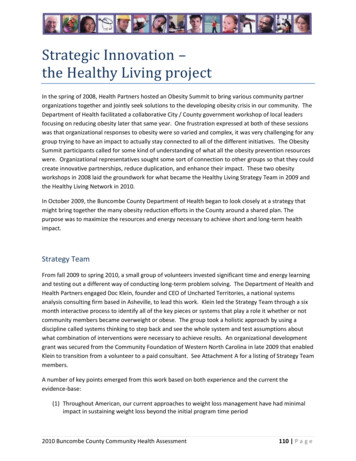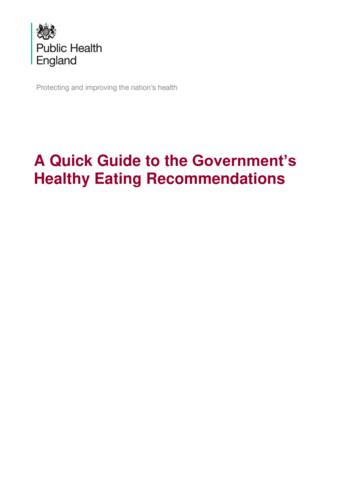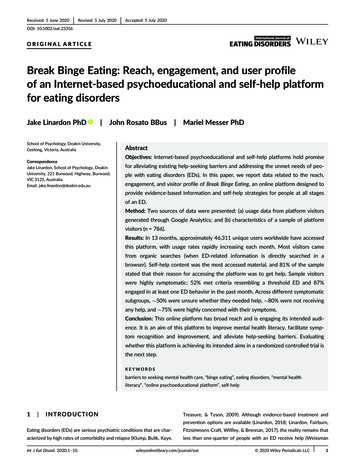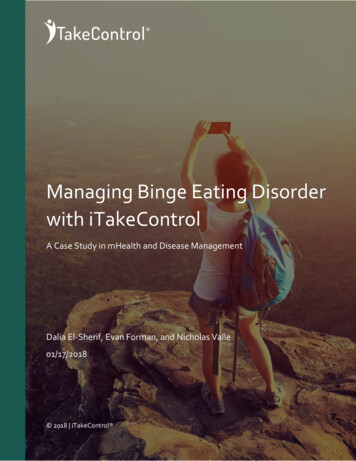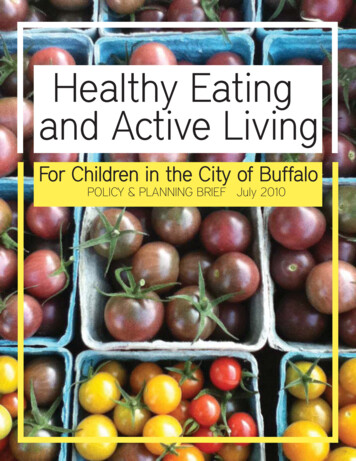
Transcription
Healthy Eatingand Active LivingFor Children in the City of BuffaloPOLICY & PLANNING BRIEF July 2010
Healthy Eating and Active LivingFor Children in the City of BuffaloChildren and youth are the future of our community andthe nation. Children and youth living in Buffalo face anumber of challenges that threaten their well-being andquality of life. A key among these challenges is children’slimited access to environments that facilitate healthyeating and active living behavior. Healthy Kids HealthyCommunities-Buffalo (HKHC-Buffalo)2, a collaborative effortto promote healthy eating and active living among Buffalo’schildren, is pleased to present this policy and planningbrief as the first in a series highlighting the context, trends,key challenges and opportunities, and potential policy andplanning solutions for creating healthy environments in theCity of Buffalo.Buffalo HKHC-Buffalo intends to bring evidencebased information to inform the work of policy makers,community members, professionals, and advocates who areworking tirelessly to improve the well-being of children andyouth in our community. This brief provides an overviewof the demographic and economic context within whichchildren live in Buffalo, and highlights key food and physicalactivity related challenges in the city.32
Children and Youth in the City of BuffaloFigure 1. Public School EnrollmentPopulation and GenderThe City of Buffalo is home to 62,252 childrenand youth below the age of 18.4 These young residentscomprise about a quarter of the city’s population of259,143 residents. The proportion of children andyouth in the City of Buffalo is marginally higher thanthat in Erie County (22%) and New York State (23%).Within the city, the number of male children (32,234)slightly outnumbers the female (30,018).5Educational Enrollment and AttainmentDuring the 2009-2010 school year 34,636children were enrolled in a total of 59 public schools inthe City of Buffalo. Seventy percent (24,297) of thesechildren were enrolled in Pre-K through 8th grade whilethe remaining thirty percent (10,339) were enrolled inFigure 2. Income and Poverty9th through 12th grades (see Figure 1).6High school graduation rates in Buffalo’spublic schools pose a challenge. Only 53.1 percentof students who entered public high schools in thefall of 2005 graduated by June of 2009, meetingthe standard four-year schedule for high schoolcompletion. This graduation rate is significantly lowerthan the statewide rate of 71.8 percent.7Overall, city residents’ educational attainmentrates are low as well. About 19 percent of cityresidents did not graduate from high school. This nongraduation rate is higher than in Erie County (12%) andNew York State (16%). Furthermore, only 26 percentof city residents have some form of college degree,lagging about 10 percentage points behind both the Housing Conditionssurrounding county (36%) and the state (37%).8The city of Buffalo has 140,199 housing units.Seventy-nine percent of these are occupied while aIncome and Poverty RatesChildren and their families in Buffalo face shocking 21 percent are vacant. For comparison, bothconsiderable economic challenges. The median family Erie County and New York State have vacancy ratesincome in Buffalo is 37,068.9 Nearly 30 percent of below 10.5 percent. A majority (57%) of the occupiedcity residents live below the federally-specified poverty housing units in Buffalo are home to renters, while 43line, a proportion much higher than that in Erie County percent are owner-occupied. The city has a muchlower home ownership rate than both Erie County andand New York State (14% each) (see Figure 2).Although only a quarter of Buffalo’s population New York State.Thirty percent (32,927) of all occupied housingis below the age of 18, 34.73 percent (25,775) ofBuffalo’s poor are children. In other words, children units are home to children under the age of 18. Ofdisproportionately experience poverty in the City of these, about 63% are renter-occupied, while theremaining 37% are owner-occupied. In other words,Buffalo. 10a majority of Buffalo’s children live in renter-occupiedhousing.3
The median housing value in the city is Figure 3. Children and Household StructurStructure 63,000, significantly lower than the county at large( 113,600) and the state ( 311,700). The median rentin the city is 444. Although the rent appears to bemore affordable than that in Erie County ( 503) andNew York State ( 824), there are significant concernsabout the quality of rental housing available in thecity.11Households with ChildrenA significant majority (99%) of children underthe age of 18 live in family households. Over 34,000(55%) of all children under the age of 18 are raised bya single mother while only 37 percent are raised by amarried couple (see Figure 3). Most children live witheither one or both of their parents. A small proportionlives with their grandparent(s) or some other relative(10.6%). 12Access to AutomobilesIn the city, 29.76 percent of householdsdo not have access to a vehicle. This rate is muchhigher than that in the county where only 13.28percent of households lack access to an automobile.Automobile ownership is more limited among rentersthan home owners in the City of Buffalo. Of thosehouseholds who lack access to automobiles, about 85percent are renters, while only 15 percent own homes.Limited access to automobiles constrainsresidents’ access to healthful foods, especially whenthere are few supermarkets and farmers marketswithin their neighborhoods.Limited access to vehicle access is, however,associated with higher rates of active commuting towork in an adult population. For example, about sevenpercent of Buffalo residents currently walk/bike to Figure 4. Racial Diversitywork, which is higher than that in the surroundingcounty (3.4%) where household automobile ownershipis also higher (87%).13Racial DiversityA significant proportion of children andyouth in the City of Buffalo are African American(48%) while an additional 40 percent are white.14These proportions vary slightly from those in theoverall population wherein a majority of Buffaloniansreport themselves to be white (52.23%), while 39.09percent report themselves to be African American(see Figure 4).The city has a small foreign born population. Ofall children between 5 and 17 years old, 1,714 (3.7%)are foreign born. Overall, 13,400 (5.2%) city residentsare foreign born. 154
Healthy Eating and Active Living Trendsin the Buffalo AreaPersistent Food InsecurityFigure 5. Food Insecurity among HouseholdsA significant proportion of households withchildren under the age of 18 experience food insecurity. with ChildrenOf the 32,927 households with children in the City ofBuffalo, 39 percent (12,842) receive food assistance.Households with children appear to supplement theirfood needs with federal food assistance16 at a higherrate than the general population - only 24 percentof all households in the city rely on food assistance.Children’s emergency food needs in Buffalo are metby the Western New York food bank. In fact, thirtyeight percent of those served by the Western NewYork Food Bank are children and youth under the ageof 18.17Data suggests that Buffalo households withchildren are less food secure compared to the stateand the nation. Only 14.8 percent of New York Statehouseholds with children, and 16.2 percent of UShouseholds with children, were reported to be foodHigh Rates of Overweight and Obesityinsecure (see Figure 5). 18Along with food insecurity, children and youthin our community are at risk of obesity. In 2009, 26.6percent of New York State high school students wereFigure 6. Overweight and Obesity Rates among either overweight (15.6%) or obese (11.0%) based onAdults and High School Childrentheir Body Mass Index (BMI) scores. The prevalence ofoverweight and obesity among students has increasedsince 1999 (see Figure 6). 19In 2008, an astounding 68 percent of adultresidents in the City of Buffalo were either overweightor obese. About 40 percent were overweight while 28percent were obese based on their Body Mass Index(BMI) scores. The prevalence rates of overweight andobesity in Buffalo are similar to those in Erie Countybut higher than those in New York State (67% and60%, respectively) (see Figure 6).Obesity can lead to many serious healthproblems such as high cholesterol, high bloodpressure, heart attack, heart disease, stroke, asthma,and diabetes. The Buffalo-Cheektowaga-Tonawandametro region has higher percentages than New YorkState in all of these diseases except for asthma. Forexample, in 2008, 9.3 percent of adult Buffalo metroresidents had diabetes compared to 8.4 percent ofadult New York State residents. 205
Figure 7. Percentage of Population ConsumingFew children in our community eat well. The Adequate Fruits and VegetablesLow Consumption of Fruits and Vegetablesconsumption of fruits and vegetables among highschool students is especially low. In 2005, only 21.7percent of New York State high school students atethe required five servings of fruits and vegetablesper day. This rate has been steadily decreasing since1999.21Fruit and vegetable consumption among adultsis reported to be slightly higher: 27 percent of adults inNew York State and 28.8 percent of adults in the cityof Buffalo eat five servings of fruits and vegetablesper day (see Figure 7). 22Low Levels of Physical ActivityChildren and youth in our community are alsoengaging in limited physical activity. For example, in2009, 57.7 percent of high school students in NewYork state failed to meet the minimum recommended Figure 8. Percentage of Population Failingphysical activity requirements of 60 minutes of to Meet Physical Activity Guidelinesmoderate physical activity five or more days per week.Seventeen percent of New York State high schoolstudents were completely physically inactive (seeFigure 8). Although these rates appear dire, they are animprovement over past trends. In 2005, for example,70.4 percent high school students in New York statedid not meet minimum physical activity requirementsand 27.4 percent students were completely inactive. 23Adult Buffalo metro area residents’ physicalactivity behaviors are also better than that of youth.In 2007, a majority (52.5%) of metro residents failedto meet the minimum recommended physical activityrequirements of 30 minutes of moderate physicalactivity five or more days per week or 20 minutesof vigorous physical activity three or more days perweek. The failure to meet minimum recommendedrequirements for physical activity mirrors the rates inthe county (52.8%) and the state (51.1%) (see Figure8). 24Next StepsAlthough many challenges exist in Buffalo, a number of dedicated organizations, agencies, and individualsin the City of Buffalo are working to increase healthy eating and active living opportunities for children livingin the City of Buffalo. Community groups supporting active living and healthy eating are being established.Community gardens are springing up. Bicycle racks are being installed. Urban farming is becoming popular. Tosupport these and many other grassroots efforts, future policy and planning briefs from HKHC-Buffalo will bringinformation, ideas, and best practices to bear upon the community’s collective effort to create systemic andsustainable city-wide change to support healthy eating and active living for Buffalo’s children.6
Notes1. Photograph provided by the Massachusetts Avenue Project, Buffalo, New York. Photograph taken January 01, 2004.2. Healthy Kids Healthy Communities-Buffalo is a collaborative partnership of multiple public and non-profit sectororganizations. The partnership, which is funded by the Robert Wood Johnson Foundation, is led by the Buffalo NiagaraMedical Campus, Inc., and includes the Buffalo Public Schools, City of Buffalo, Erie County Health Department, GreenOptions Buffalo, the Massachusetts Avenue Project, the Wellness Institute, and the University at Buffalo (UB). The policybriefs for HKHC-Buffalo are produced by the Healthy Eating and Active Living Environments Project in the Departmentof Urban and Regional Planning at UB.3. There is limited demographic and economic data available for children in the city of Buffalo. The finest scale healthdata for children is on the state level.4. For the purpose of this policy brief, residents under the age of 18 are classified as children and young adults; thepolicy brief refers to this population interchangeably as children and/or youth.5. 2006-2008 American Community Survey, US Census Bureau.6. Buffalo City School District BEDS Data 2009-2010. Office of Shared Accountability.7. New York State Education Department. “Graduation Rates.” Retrieved July 21, 2010 dRateSlidesFINAL.ppt.8. 2006-2008 American Community Survey, US Census Bureau.9. All dollar amounts are in 2008 inflation-adjusted dollars.10. 2006-2008 American Community Survey, US Census Bureau.11. 2006-2008 American Community Survey, US Census Bureau.12. 2006-2008 American Community Survey, US Census Bureau.13. 2006-2008 American Community Survey, US Census Bureau.14. 2000 Decennial Census, US Census Bureau.15. 2006-2008 American Community Survey, US Census Bureau.16. 2006-2008 American Community Survey, US Census Bureau.17. Food Bank of Western New York.18. US Department of Agriculture. Food Environment Atlas Documentation. Retrieved July 26, 2010 m#hh2008.19. Youth Risk Behavior Surveillance System. Centers for Disease Control. Retrieved July 26, 2010 .20. Behavioral Risk Factor Surveillance System. Centers for Disease Control. Retrieved June 3, 2010 fromhttp://www.cdc.gov/brfss/smart/index.htm.21. Youth Risk Behavior Surveillance System. Centers for Disease Control. Retrieved July 26, 2010 .22. Behavioral Risk Factor Surveillance System. Centers for Disease Control. Retrieved June 3, 2010 fromhttp://www.cdc.gov/brfss/smart/index.htm.23. Youth Risk Behavior Surveillance System. Centers for Disease Control. Retrieved July 26, 2010 .24. Behavioral Risk Factor Surveillance System. Centers for Disease Control. Retrieved June 3, 2010 fromhttp://www.cdc.gov/brfss/smart/index.htm.For more information contact: Kailee Neuner, Research CoordinatorDepartment of Urban and Regional PlanningSchool of Architecture and PlanningUniversity at Buffalo108 D Hayes Hall, 3435 Main StreetBuffalo, New York 14214kmneuner@buffalo.edu716-829-52347
Healthy Eating and Active Living FFor Children in the City of Buffaloor Children in the City of Buffalo Children and youth are the future of our community and the nation. Children and youth living in Buffalo face a number of chall
